Get your dose of History via Email
Introduction to Mawangdui
The Mawangdui site is an archaeological treasure that offers profound insights into the Han Dynasty of ancient China. Located in Changsha, Hunan Province, this important excavation comprises tombs belonging to members of the Chu state, which were sealed in 168 BC. The site first caught scholarly attention in the 1970s when it yielded a significant number of artifacts and documents, providing a window into the culture, arts, and medical knowledge of the time.
Archaeological Discovery and Excavation
The tombs at Mawangdui were first uncovered in 1972, and the subsequent excavation unearthed a hoard of artifacts and historical documents that have been preserved with exceptional care. This important archaeological venture unearthed three tombs: those of Marquis Li Cang, his wife Lady Dai (Xin Zhui), and their son. Among the tombs, Lady Dai’s is the most famous, primarily because of her remarkably well-preserved mummy and the wealth of artifacts found within her burial chamber.
Insights into the Han Dynasty Burial Practices and Beliefs
The burial practices conducted for Lady Dai and her family provide a clear picture of the complex burial rites and beliefs of the Han Dynasty elite. The meticulous arrangement of the burials, with the coffins placed in wooden houses beneath earthen mounds, reflects the sophistication and the cosmological and philosophical beliefs practiced during the period. The tomb treasures, including lacquerware, silk garments, and other fine goods, exemplify the high level of craftsmanship and the importance of wealth and status in the society.
Preservation of Organic Materials
One of the most significant aspects of the Mawangdui discoveries is the extraordinary preservation of organic materials. Lady Dai’s mummy was found in a state of near-perfect preservation, lending researchers invaluable biological information about life and health during the Han period. Additionally, the site rendered over a thousand well-preserved artifacts made from organic materials like silk, bamboo, and wood, which typically are lost to decay. The sealed tomb condition created an environment that significantly reduced the decomposition process.
The Mawangdui Texts
The wealth of knowledge recovered from the Mawangdui extends to a wide array of silk manuscripts and documents that were interred with the deceased. These texts cover topics as diverse as music, astronomy, and medical practices, including acupuncture and moxibustion, offering a comprehensive understanding of the intellectual and scientific endeavors of the time. Of these documents, one of the most remarkable is the Mawangdui Silk Texts, which represent some of the earliest examples of Chinese written works, providing priceless context to the evolution of Chinese script and literature.
Contributions to Medical History
The Mawangdui site has significantly contributed to the understanding of early Chinese medical history. The texts found within include the “Prescriptions for Fifty-Two Ailments,” which predates the earliest known Chinese medical texts, the Huangdi Neijing. These prescriptions provide evidence of herbal medicine practices, and the presence of acupuncture needles in the tombs suggests sophisticated medical practices were already in effect more than two millennia ago.
Artistic and Aesthetic Revelations
Moreover, the high level of artistic skills and the aesthetic standards of the Han Dynasty are evident through the objects recovered. Among them, the lacquerware is particularly remarkable, characterized by intricate designs and fine detailing, which add to our understanding of the art and aesthetics of the era.
Impact on the Political and Social Landscape
The Mawangdui discoveries have also shed light on the political hierarchy and social landscape during the Han Dynasty. The eminence of Marquis Li Cang and his family within the Chu state and their connection to the Han central government testify to the administrative structures and the intricate social and political networks that existed in ancient China. The array of goods found in the tombs reflects the wealth distribution and the significance of material culture in demonstrating social status and political power.
Conclusion
In summary, the Mawangdui site is a cornerstone of archaeological and historical significance that has enabled a greater understanding of China’s Han Dynasty. The preservation of artifacts and the breadth of topics covered by the recovered texts provide an incomparable source for academic study. As excavations and research continue, Mawangdui promises to inform and inspire scholars for years to come.
Sources:

